Blog & Latest Updates
Fly Fishing Articles
Insects by Common Name


> > Miscellaneous
Landscape & scenery photos from Miscellaneous

My frequent fishing partner Brad Bohen spotted and photographed this beer poster in Brule, WI. He's got a good eye for trout, and this one looked familiar. Sure enough, it's a 15 incher I caught on the Beaverkill in the Catskills in August 2004 on an emergent sparkle pupa. I posted it here.
StateWisconsin
LocationBrule, WI
Date TakenApr 8, 2006
Date AddedApr 8, 2006
AuthorTroutnut
CameraCanon EOS 20D

On my way to a favorite brook trout stream, I spotted several sandhill cranes in a Wisconsin farm field.
StateWisconsin
LocationRusk County, WI
Date TakenAug 14, 2004
Date AddedJan 18, 2006
AuthorTroutnut
CameraOlympus C740UZ
On-stream insect photos from Miscellaneous
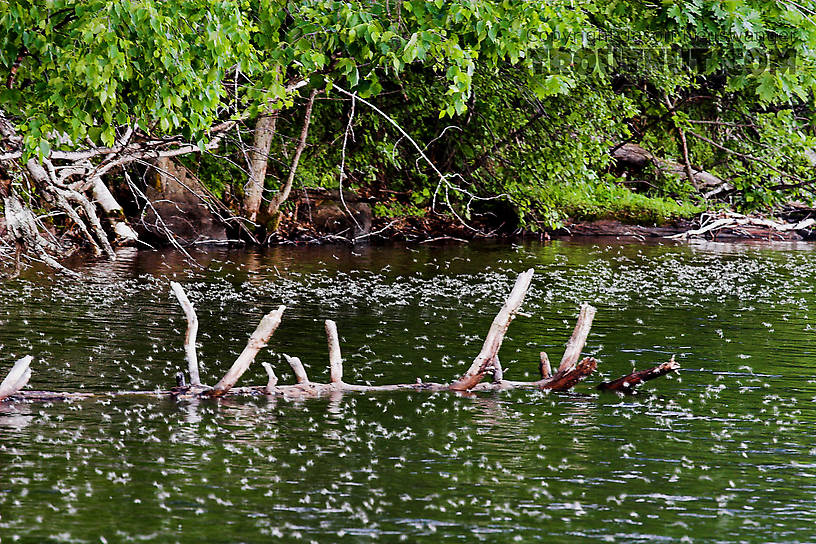
These caddisflies were thick over the water in the evening on a cold, clear northwoods lake. They were in many places on the lake, all closer to the shady shore, which also was the shore most sheltered from the wind. I'm not sure which of those features attracted them.
StateWisconsin
LocationLake Owen
Date TakenJun 10, 2006
Date AddedJun 30, 2006
AuthorTroutnut
CameraCanon EOS 20D
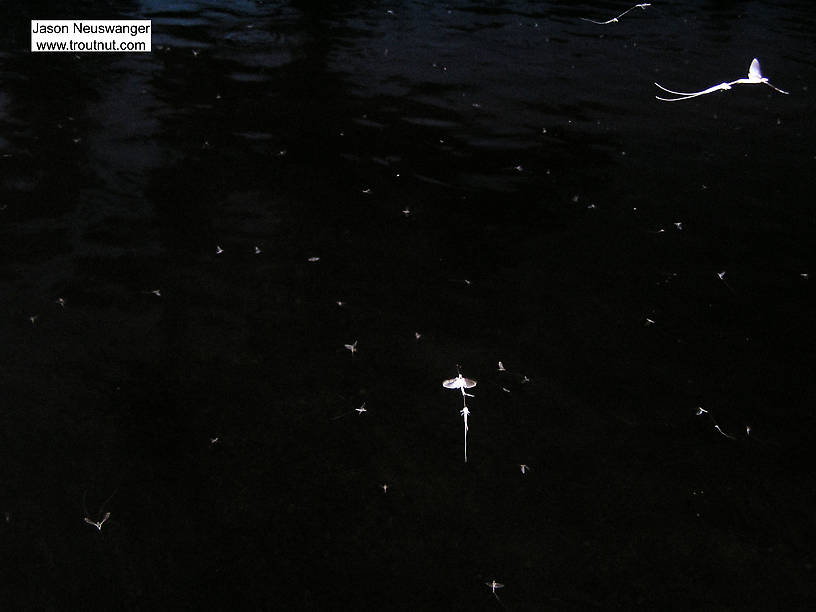
This nighttime flash photograph shows a bunch of Ephoron mayflies flying around during the hatch. So many of them fly around with their dun shucks (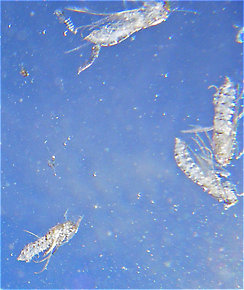 Shuck: The shed exoskeleton left over when an insect molts into its next stage or instar. Most often it describes the last nymphal or pupal skin exited during emergence into a winged adult.) attached that it seems like they molt from the dun to spinner stage in mid-air. Actually they molt on streamside vegetation like other mayflies, but they sometimes take off to mate before they're completely finished.
Shuck: The shed exoskeleton left over when an insect molts into its next stage or instar. Most often it describes the last nymphal or pupal skin exited during emergence into a winged adult.) attached that it seems like they molt from the dun to spinner stage in mid-air. Actually they molt on streamside vegetation like other mayflies, but they sometimes take off to mate before they're completely finished.

Here's an underwater view of the pupal shucks of several already-emerged Brachycentrus numerosus caddisflies.

This is Nectopsyche albida. Elongate wing connotes female.
StateWisconsin
LocationLake Owen
Date TakenJun 10, 2006
Date AddedJun 30, 2006
AuthorTroutnut
CameraCanon EOS 20D

StateWisconsin
LocationLake Owen
Date TakenJun 10, 2006
Date AddedJun 30, 2006
AuthorTroutnut
CameraCanon EOS 20D
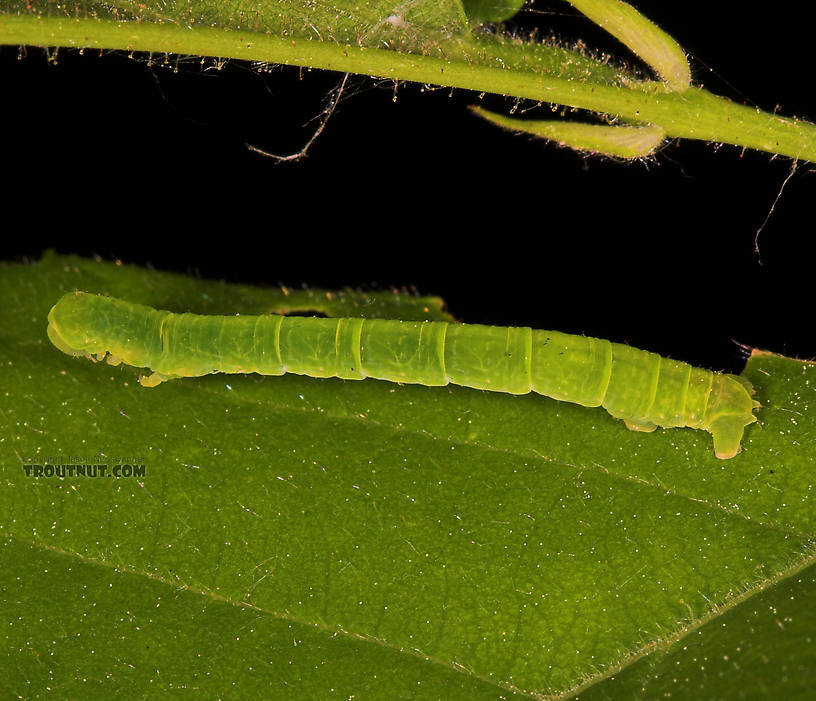
StateWisconsin
LocationHome
Date TakenJun 7, 2006
Date AddedJun 30, 2006
AuthorTroutnut
CameraCanon EOS 20D
Videos from Miscellaneous
Two Phryganeidae caddis larvae fighting over a case
Starring: Phryganeidae Caddisfly Larva
Caddisfly larvae of this family can easily leave and re-enters their cases. I caught two of them playing musical chairs or something with this one... funny!
StateWisconsin
Locationunknown
Date ShotMar 1, 2004
Date AddedMar 31, 2006
AuthorTroutnut
CameraOlympus C740UZ
Hexagenia
Starring: Hexagenia limbata Mayfly Nymph
This is one of the earliest videos I made, and I was experimenting with a tank and background that didn't work very well.
StateWisconsin
Locationunknown
Date ShotJan 12, 2004
Date AddedMar 31, 2006
AuthorTroutnut
CameraOlympus C740UZ
Water Boatman Rowing
Starring: Corixidae Water Boatman Adult
Water boatmen are excellent swimmers, and you can see here how they use their oars to push themselves through the water, a motion easily imitated by the fly fisher.
StateWisconsin
Locationunknown
Date ShotJan 31, 2004
Date AddedMar 31, 2006
AuthorTroutnut
CameraOlympus C740UZ
Closeup insects from Miscellaneous
Pteronarcys dorsata (Giant Black Stonefly) Stonefly Nymph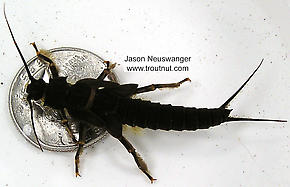 View 8 Pictures
View 8 Pictures
 View 8 Pictures
View 8 PicturesCollected February 7, 2004 from the Namekagon River in Wisconsin
Added to Troutnut.com by Troutnut on January 25, 2006
Added to Troutnut.com by Troutnut on January 25, 2006
Triaenodes Caddisfly Adult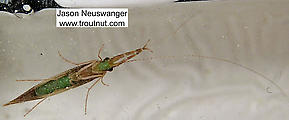 View 4 Pictures
View 4 Pictures
 View 4 Pictures
View 4 PicturesCollected August 7, 2004 from unknown in Wisconsin
Added to Troutnut.com by Troutnut on January 25, 2006
Added to Troutnut.com by Troutnut on January 25, 2006
Cyprinidae (Minnows) Minnow Adult View 4 PicturesBluntnose Minnow
View 4 PicturesBluntnose Minnow
Pimephales notatus
 View 4 PicturesBluntnose Minnow
View 4 PicturesBluntnose MinnowPimephales notatus
Collected July 14, 2003 from unknown in Wisconsin
Added to Troutnut.com by Troutnut on January 19, 2006
Added to Troutnut.com by Troutnut on January 19, 2006
Male Maccaffertium modestum (Cream Cahill) Mayfly Spinner View 4 Pictures
View 4 Pictures
 View 4 Pictures
View 4 PicturesCollected August 5, 2004 from unknown in Wisconsin
Added to Troutnut.com by Troutnut on January 25, 2006
Added to Troutnut.com by Troutnut on January 25, 2006
Ephemerella subvaria (Hendrickson) Mayfly Nymph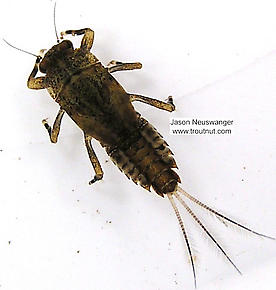 View 7 PicturesThis is another unusual brown Ephemerella nymph. The "fan-tail" which defines the Ephemerella genus is particularly evident on this specimen.
View 7 PicturesThis is another unusual brown Ephemerella nymph. The "fan-tail" which defines the Ephemerella genus is particularly evident on this specimen.
 View 7 PicturesThis is another unusual brown Ephemerella nymph. The "fan-tail" which defines the Ephemerella genus is particularly evident on this specimen.
View 7 PicturesThis is another unusual brown Ephemerella nymph. The "fan-tail" which defines the Ephemerella genus is particularly evident on this specimen.Collected February 7, 2004 from unknown in Wisconsin
Added to Troutnut.com by Troutnut on January 25, 2006
Added to Troutnut.com by Troutnut on January 25, 2006
Start a Discussion of Miscellaneous:
Top 10 Fly Hatches
Top Gift Shop Designs
Eat mayflies.
Top Insect Specimens
Miscellaneous Sites
Troutnut.com is copyright © 2004-2024 Jason
Neuswanger (email Jason). See my FAQ for information about use of my images.
 privacy policy
privacy policy
